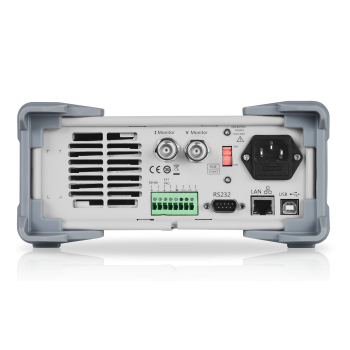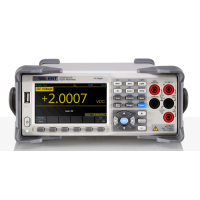Η Εταιρία μας είναι σε διακοπές από τις 11-8-2025 έως τις 29-8-2025.
Όλες οι παραγγελίες θα εκτελεστούν στις αρχές Σεπτεμβρίου.
SDL1020X Προγραμματιζόμενο DC Φορτίο
Κύρια Χαρακτηριστικά
- DC 150 V/30 A, μέγιστη ισχύ έως 200 W
- 4 επιλογές στατικής λειτουργίας : CC/CV/CR/CP
- CC δυναμική λειτουργία: Continuous, pulsed, toggled
- CC δυναμική λειτουργία: 25 kHz, CP δυναμική λειτουργία: 12.5 kHz, CV δυναμική λειτουργία: 0.5 Hz
- Ταχύτητα μέτρησης τάσης και ρεύματος: έως 500 kHz
- Μεταβαλλόμενος χρόνος ανύψωσης ρεύματος: 0.001 A/us έως 2.5 A/us
- Ελάχιστη ανάλυση ανάγνωσης τιμών: 0.1 mV, 0.1 mA
- Λειτουργία αντιστάθμισης 4-wire SENSE
- Υποστήριξη έως και 100 βημάτων για τον προγραμματισμό λειτουργίας
- Η λειτουργία προγραμματισμού, υποστηρίζει έως και 50 ομάδες βημάτων
- Προστασία OCP, OVP, OPP, OTP και LRV
- Εξωτερικός αναλογικός έλεγχος
- Εποπτεία τάσης και ρεύματος μέσω σημάτων 0-10 V
- Οθόνη 3.5 ίντσες TFT-LCD, ικανή να προβάλει πολλαπλές παραμέτρους ταυτόχρονα
- Ενσωματωμένη διεπαφή RS232/USB/LAN , USB-GPIB επικοινωνία (κατ' επιλογή)
- Περιλαμβάνει λογισμικό για PC: Υποστήριξη SCPI, LabView driver
Steady state operating mode

The SDL features four operating modes to provide flexible test capabilities. In CC mode, the electronic load will sink a constant current, regardless of the voltage at its terminals. In CV mode, the electronic load will cause a constant voltage to appear at its terminals. In CR mode, the electronic load will behave as a fixed resistance value. As shown in the figure, the electronic load will linearly change the current according to the input voltage. In CP mode, the electronic load will cause a constant power to be dissipated in the load.
Dynamic test mode up to 25 kHz (CC)

The transient test allows switching between two different load values. A common application is to test the dynamic characteristics of a DC source or DUT (Device-Under- Test). The transient test function enables the load to periodically switch between two set levels (Level A and Level B). The highest frequency can be set to 25 kHz in CC mode. The highest frequency can be set to 12.5 kHz in CP modes.
Simplify complex sequencing

Using the list operation function you can generate complex load sequences quickly using the list operation function. Here, you can edit the setpoints, dwell time, and slew rate for each step in the
test. *Slew rate can only be edited in CC mode.

4-wire SENSE compensation mode function

In CC/CV/CR/CW mode, when a load is connected to a power supply, it will cause a large voltage-drop on the connection lines between tested instrument and terminals of load. Using remote sense, you can measure the voltage at the DUTs input terminals, effectively removing the additional error due to the voltage drop in the connection wires.You can generate complex load sequences quickly using the list operation function. Here, you can edit the setpoints, dwell time, and slew rate for each step in the
test. *Slew rate can only be edited in CC mode.
Program function

In program (auto-test) mode, you can generate a sequence of tests using different modes, mode parameters and duration. This function is useful for automatically executing a set of tests on a device then display whether the tests passed or failed. Test results are easily viewed by pressing the up and down buttons. The load provides 8 nonvolatile registers to save auto-test file for recall later. Each file contains 1-50 steps to set up. Auto-test function is especially useful in the designing battery charging circuitry.
Battery discharge function

The SDL1020X can also provide insight into battery performance by analyzing the discharge characteristics of the DUT. The SDL features three stop conditions for the discharge test: Voltage, capacity or time. The discharge process is immediately terminated if the stop conditions are met. This provides more control over the test termination and an extra layer of safety during critical tests. Throughout the test process the battery voltage, discharge current, discharge time and discharged capability is displayed clearly on the LCD panel.
OCPT/OPPT Mode
Over-current protection (OCPT) mode prevents drawing too much current from the DUT.
Overpower-protection (OPPT) mode: When the input voltage has reached the Von point, the load will draw power after a delay time. The power value will increase by a step size at regular intervals. Simultaneously, the DC load will judge whether the input voltage is lower than OPP voltage you have set, if it is, then the present current value will be compared to see if it is in the current range you have set.
CR-LED Mode

The SDL1020X includes a CR-LED mode specifically for LED driver testing. Basing on the traditional CR mode, CR-LED mode adds a diode breakover voltage setting. When the input voltage is above this set value, the DC load start to work. Thus, it can emulate the actual characteristics of an LED.
Voltage Rise/Fall speed test

The electronic load is also equipped to directly measure voltage rise and fall times. It can calculate the time from one voltage to another without the need for additional measurement instrumentation. With an SDL1020X, you can save money and improve efficiency.
Voltage threshold function

The SDL1020X can be set to turn on or off if the input voltage is at, above, or below a set value. By defining these thresholds, you control when the load is active. Which minimizes test time and increases safety.
Waveform trend chart function

The electronic load includes a waveform display function and supports the following operations for the waveform: Pause, recording, and capturing the waveform. You can quickly observe the trends of parameter changes as they occur throughout the test.
Save/Recall setting parameters

The load allows you to save different types of files to the internal and external memories. You can recall and read them when necessary.
External analog control
The load allows the user to control current or voltage through external analog terminals (EXT PRG). Input a 0-10 V analog to adjust 0-100% rated voltage and current. It is very useful for those applications that need to change the input value with external signals.
Multiple protection modes
The SDL1020X Programmable DC Electronic Load provides five protection types: OVP, OCP, OPP, OTP and LRV. When OVP/OCP/OPP/OTP/reverse voltage protection (LRV) occurs, the load will immediately turn off the input and stop sinking. Then, a prompt message is displayed.





